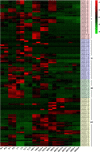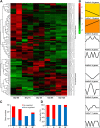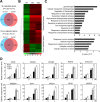Characterization of wheat homeodomain-leucine zipper family genes and functional analysis of TaHDZ5-6A in drought tolerance in transgenic Arabidopsis
- PMID: 32005165
- PMCID: PMC6993422
- DOI: 10.1186/s12870-020-2252-6
Characterization of wheat homeodomain-leucine zipper family genes and functional analysis of TaHDZ5-6A in drought tolerance in transgenic Arabidopsis
Abstract
Background: Many studies in Arabidopsis and rice have demonstrated that HD-Zip transcription factors play important roles in plant development and responses to abiotic stresses. Although common wheat (Triticum aestivum L.) is one of the most widely cultivated and consumed food crops in the world, the function of the HD-Zip proteins in wheat is still largely unknown.
Results: To explore the potential biological functions of HD-Zip genes in wheat, we performed a bioinformatics and gene expression analysis of the HD-Zip family. We identified 113 HD-Zip members from wheat and classified them into four subfamilies (I-IV) based on phylogenic analysis against proteins from Arabidopsis, rice, and maize. Most HD-Zip genes are represented by two to three homeoalleles in wheat, which are named as TaHDZX_ZA, TaHDZX_ZB, or TaHDZX_ZD, where X denotes the gene number and Z the wheat chromosome on which it is located. TaHDZs in the same subfamily have similar protein motifs and intron/exon structures. The expression profiles of TaHDZ genes were analysed in different tissues, at different stages of vegetative growth, during seed development, and under drought stress. We found that most TaHDZ genes, especially those in subfamilies I and II, were induced by drought stress, suggesting the potential importance of subfamily I and II TaHDZ members in the responses to abiotic stress. Compared with wild-type (WT) plants, transgenic Arabidopsis plants overexpressing TaHDZ5-6A displayed enhanced drought tolerance, lower water loss rates, higher survival rates, and higher proline content under drought conditions. Additionally, the transcriptome analysis identified a number of differentially expressed genes between 35S::TaHDZ5-6A transgenic and wild-type plants, many of which are involved in stress response.
Conclusions: Our results will facilitate further functional analysis of wheat HD-Zip genes, and also indicate that TaHDZ5-6A may participate in regulating the plant response to drought stress. Our experiments show that TaHDZ5-6A holds great potential for genetic improvement of abiotic stress tolerance in crops.
Keywords: Drought tolerance; Expression profiles; HD-zip gene family; Phylogenetic relationships; TaHDZ5-6A; Wheat.
Conflict of interest statement
The authors declare that they have no conflict of interest.
Figures








Similar articles
-
A matter of quantity: Common features in the drought response of transgenic plants overexpressing HD-Zip I transcription factors.Plant Sci. 2016 Oct;251:139-154. doi: 10.1016/j.plantsci.2016.03.004. Epub 2016 Mar 15. Plant Sci. 2016. PMID: 27593472
-
FaTEDT1L of Octoploid Cultivated Strawberry Functions as a Transcriptional Activator and Enhances Abiotic Stress Tolerance in Transgenic Arabidopsis.Int J Mol Sci. 2024 Sep 19;25(18):10091. doi: 10.3390/ijms251810091. Int J Mol Sci. 2024. PMID: 39337577 Free PMC article.
-
A novel maize homeodomain-leucine zipper (HD-Zip) I gene, Zmhdz10, positively regulates drought and salt tolerance in both rice and Arabidopsis.Plant Cell Physiol. 2014 Jun;55(6):1142-56. doi: 10.1093/pcp/pcu054. Epub 2014 May 8. Plant Cell Physiol. 2014. PMID: 24817160
-
HD-ZIP Gene Family: Potential Roles in Improving Plant Growth and Regulating Stress-Responsive Mechanisms in Plants.Genes (Basel). 2021 Aug 17;12(8):1256. doi: 10.3390/genes12081256. Genes (Basel). 2021. PMID: 34440430 Free PMC article. Review.
-
Transcription factors involved in drought tolerance and their possible role in developing drought tolerant cultivars with emphasis on wheat (Triticum aestivum L.).Theor Appl Genet. 2016 Nov;129(11):2019-2042. doi: 10.1007/s00122-016-2794-z. Epub 2016 Oct 13. Theor Appl Genet. 2016. PMID: 27738714 Review.
Cited by
-
Phenotypic and Genotypic Diversity of Roots Response to Salt in Durum Wheat Seedlings.Plants (Basel). 2023 Jan 16;12(2):412. doi: 10.3390/plants12020412. Plants (Basel). 2023. PMID: 36679125 Free PMC article.
-
Genetic dissection of protein and starch during wheat grain development using QTL mapping and GWAS.Front Plant Sci. 2023 Jun 12;14:1189887. doi: 10.3389/fpls.2023.1189887. eCollection 2023. Front Plant Sci. 2023. PMID: 37377808 Free PMC article.
-
Single START-domain protein Mtsp17 is involved in transcriptional regulation in Mycobacterium smegmatis.PLoS One. 2021 Apr 15;16(4):e0249379. doi: 10.1371/journal.pone.0249379. eCollection 2021. PLoS One. 2021. PMID: 33857164 Free PMC article.
-
Transcriptome Analysis of Developing Grains from Wheat Cultivars TAM 111 and TAM 112 Reveal Cultivar-Specific Regulatory Networks.Int J Mol Sci. 2022 Oct 21;23(20):12660. doi: 10.3390/ijms232012660. Int J Mol Sci. 2022. PMID: 36293517 Free PMC article.
-
MsHDZ23, a Novel Miscanthus HD-ZIP Transcription Factor, Participates in Tolerance to Multiple Abiotic Stresses.Int J Mol Sci. 2024 Mar 13;25(6):3253. doi: 10.3390/ijms25063253. Int J Mol Sci. 2024. PMID: 38542226 Free PMC article.
References
MeSH terms
Substances
Grants and funding
LinkOut - more resources
Full Text Sources

